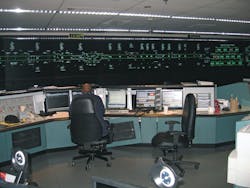Fire Management Capable of Continuous Improvement
Ask any leader in public transit what their number one concern is and they will most likely say "safety." Ask them whether they are thinking of riders or employees, and most likely they will answer "both." If you were to quiz a little further, and ask them to be more specific about what kind of incident they may generally worry about, and most likely they will say "fire."
They would say fire not just because of what can happen when a fire erupts, but what can result from smoke, especially in an enclosed hard-to-reach location where riders could be trapped for a prolonged period of time. So how a transit service provider goes about designing its fire management, intrusion detection, station and tunnel ventilation, station traction, uninterruptible power systems, and station control center booths speaks volumes about the service provider's preparedness in any kind of emergency.
While every transit system has some form of fire management method, and many transit service providers have systems with similar components, all cannot claim to have a system that is "state-of-the-art." In other words, a system that is expandable and designed so that it is recognized by experts in the field as having the capabilities to provide maximum protection regardless of where the emergency takes place.
When the system also includes such features as the ability to pinpoint the location of an emergency in record time, communicate that information to operators, and warn passengers and the public in general by communicating with them via electronic messaging systems over its own Station Local Area Network (SLAN), that's "state of the art" by any one's standards.
The Maryland Transit Administration's (MTA) Metro Fire and Security Management System (MFSMS), critical to the MTA's Metro Subway Operations, is just such a system.
With the help of more than 100 local laborers, the agency's complex MFSMS project was executed throughout all MTA Metro facilities – stations, vent shafts, the Metro Operations Control Center (MOCC), ancillary buildings and Wabash Maintenance Facility, without interrupting Metro Subway service or impeding patron access to any station.
The MFSMS system was completed in November 2010, and replaces the MTA's old Fire Management System (FMS) and Metro Central Supervisory Control System (CSCS) at the Operations Control Center. It brings to the MTA state-of-the-art capabilities in the controlling and monitoring of facilities. Additional improvements include replacement of the Motor Control Systems, overhaul of ventilation fans and dampers, and a new fiber-based Station Local Area Network (SLAN) to provide the ultimate in reliable connectivity among new fire management security devices.
Vern Hartsock, deputy director of the MTA's Office of Engineering says, "In laymen's terms the new system is state of the art, smarter and basically runs itself.
"For example, while the old system could alert us when a door was opened, with the new swipe-card system we can now know who opened a door and when. The old system was difficult to upgrade, but the new system makes it much easier."
Harstock continues, "Perhaps equally important and of interest to our riders is the system's ability to allow us to know exactly where a particular train is (in real time) and its estimated time of arrival at a particular station. We can relay this information via our station's public address system to riders. In the future the ability to receive this information on a standard SMS or other handheld device could be added."
MTA's Engineering, Metro, Service Quality and Safety departments worked together to put the new system in place along with Gill-Simpson Inc., and Arinc Inc. The systems construction management team was led by Aecom. More than 400,000 man hours of on-site construction and testing took place with only one minor impact to train service.
As transit agencies wrestle with how to do more with less, their need for vigilance when it comes to safety measures will not diminish. The International Organization for Standardization (ISO) identifies the following principles of risk management. According to ISO, risk management should create value, explicitly address uncertainty and take human factors into account, as well as be:
- An integral part of organizational processes
- Part of decision making
- Systematic and structured
- Based on the best available information
- Tailored
- Transparent and inclusive
- Dynamic, iterative and responsive to change
- Capable of continuous improvement and enhancement
When designing the MTA's new fire management system, the MTA followed those principles from start to finish. What's more, because the creative team paid particular attention to making the system capable of continuous improvement, future iterations of the system will be able to utilize today's (and tomorrow's) new media to keep passengers and staff informed of service changes almost instantly.
The American Council of Engineering Companies (ACEC), the premiere council of "experts in the field of engineering" has decided to award the MTA its National Recognition Award for 2012.
The award will be presented during special ceremonies at the ACEC's annual Engineering Excellence Awards (EEA) Convention and Legislative Summit on April 17, 2012 in Washington, D.C. The ACEC's award gala has become the engineering industry's highest profile event, and attracts more than 600 members, guests, national industry leaders and members of Congress and the Administration.
While the MTA is excited to be receiving the National Recognition Award from the ACEC, and pleased to add it to the three awards the MFSMS system has already earned, the system itself is the real star. The entire project was completed within budget and six months ahead of schedule.
